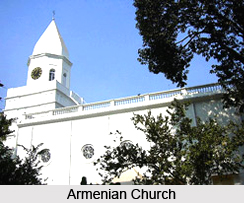Armenian Church is often regarded as the oldest church in Kolkata, a commemoration of the Armenian community living in Kolkata. The Church looks after the age-old religious institution, which has been serving the Armenians since 1724. Kolkata with its diverse culture has been home to a large number of foreign religious communities, since it was the capital of the British East India Company. Dutch, French, Chinese, Jews were others alongside Armenians who settled down. Their remnants have been preserved and from this can be traced a rich cultural and historical past. The Armenians community was prevalent in the first half of the 17th century when they settled here and in a natural way owe their loyalty to the Armenian Church we known for its traditional orthodoxy.
 Located at 1 Armenian Street, at the northwest corner of Barabazaar, nearby Howrah Bridge. The Church represents the 150 odd Armenian families still inhabiting the city.
An Armenian Aga Nazar built the Church, and Kenanentekh Phanoosh donated the land for the church, Katchik Arfiel gave the architectural guidance. He was also a guiding factor in building the residential blocks for the priests who lived there. The church had many wealthy patrons like Sir Catchik Paul Chater, who contributed to its benefit. The outer and inner walls of the Church are complete with remembrances of departed Armenians of Kolkata. Coming to the architectural details, the whole structure is wonderfully built with white and black marbles in a harmonious blend. There is a gallery on the first floor of the Church, which has a connecting spiraling staircase. The alter which is composed of a cross, the gospels and 12 candlesticks depicting Christ and his Apostles, has three oil paintings beside it, of eminent English painter A.E. Harris. Those were namely `The Holy Trinity`, `The Last Supper` and `The Enshrouding of Our Lord` -
The commemoration is extensively done, sometimes even with silver and brass tablets being used for the engravings of the tributes. These mostly family memorials that constitute the engravings in the church walls. The engravings reflect a strong sentimental and emotional nostalgia about the Armenians trying to maintain their integrity and identity outside their homeland.
Located at 1 Armenian Street, at the northwest corner of Barabazaar, nearby Howrah Bridge. The Church represents the 150 odd Armenian families still inhabiting the city.
An Armenian Aga Nazar built the Church, and Kenanentekh Phanoosh donated the land for the church, Katchik Arfiel gave the architectural guidance. He was also a guiding factor in building the residential blocks for the priests who lived there. The church had many wealthy patrons like Sir Catchik Paul Chater, who contributed to its benefit. The outer and inner walls of the Church are complete with remembrances of departed Armenians of Kolkata. Coming to the architectural details, the whole structure is wonderfully built with white and black marbles in a harmonious blend. There is a gallery on the first floor of the Church, which has a connecting spiraling staircase. The alter which is composed of a cross, the gospels and 12 candlesticks depicting Christ and his Apostles, has three oil paintings beside it, of eminent English painter A.E. Harris. Those were namely `The Holy Trinity`, `The Last Supper` and `The Enshrouding of Our Lord` -
The commemoration is extensively done, sometimes even with silver and brass tablets being used for the engravings of the tributes. These mostly family memorials that constitute the engravings in the church walls. The engravings reflect a strong sentimental and emotional nostalgia about the Armenians trying to maintain their integrity and identity outside their homeland.
The church stands as a hope among the thriving Armenians and conduct assemblies thrice a week. The church is not only a religious institution but also a storehouse of information about the past. Records of people of European origin under the Armenian Church of Kolkata who have been baptized, married and buried under it in the distant past are likely to be found in the British Library in London or at the nearest Family History Center. The Church has now become an important tourist destination upholding traditional Armenian practices and an aura of the past. This serves as a meeting place of the remaining Armenian communities sharing their religious and cultural beliefs and customs. This is a rich heritage of the distant British past, which is our contemporary reminding us of the Kolkata that existed years back.



















